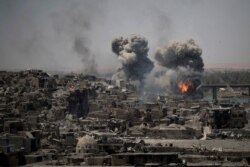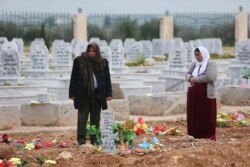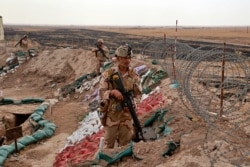Across Iraq and Syria there is a growing sense of unease that when it comes to the Islamic State terror group, data showing the jihadist force on its heels should not be trusted.
While the U.S.-led military coalition argues Islamic State is a shadow of its former self, some officials with U.S. partner forces argue the terror group has actually become more powerful and more dangerous.
“This year they have systematic attacks,” a source close to the U.S.-backed Kurdish forces in Iraq and Syria told VOA, noting that last year IS attacked many of the same areas repeatedly. “Now they are spread like cancer.”
At issue is not just the number of attacks IS has carried out in recent weeks, but the choice of targets, the tactics and the ferocity of the terror group’s latest offensive.
“In Diyala and Salahaddin [Iraq], things are so bad that some Sunni tribes are carrying weapons,” said the source, who once fought alongside U.S. forces.
'I don't believe it'
Pressed about the data showing IS attacks, while trending up in recent weeks, are not as substantial as they were at the same time last year, he said simply, “I don’t believe it.”
The terror group’s activity has likewise made an impression on Jordan's King Abdullah II, a key partner in the anti-IS coalition.
“ISIS is increasing attacks in Iraq … threatening to undo years of global efforts,” he told a special operations forces conference Tuesday, using an acronym for Islamic State.
The observations are a stark contrast to what has been described by U.S. and coalition officials.
“Over the past few months we’ve seen notable successes in the fight against Daesh,” the coalition’s commander, Lieutenant General Pat White, told reporters on a call last week from Baghdad, using another acronym for the terror group.
“They are lacking in financing, they are lacking in fighters and they are lacking in support by the populace in most areas,” he said. “The attacks that we’ve been witnessing here over the past weeks are inconsistent with an organization [IS] that we knew of in the past.”
According to the coalition’s data, IS claimed 151 attacks in April, an increase over previous months, but on par with the 152 attacks claimed in April 2019.
Records kept by the Armed Conflict Location and Event Data Project (ACLED), a U.S.-based nonprofit research group, reveal a similar trend.
ACLED data show IS carried out 53 attacks in Iraq and Syria in March, 103 attacks in April and 40 attacks so far this month.
Year-on-year, though, attacks are down — 330 attacks so far this year compared with 776 for the same period in 2019.
US assessment: IS operating on the margins
At the same time, ongoing U.S. assessments continue to classify IS’s efforts in Iraq and Syria as a “low-level insurgency” increasingly reliant on small arms as the group appears to be unable to manufacture or acquire the improvised explosive devices (IEDs) that it once favored.
The assessments from U.S. Central Command, the Defense Intelligence Agency and the U.S.-led coalition, shared in a report Wednesday by the Defense Department inspector general, also see IS as a group still operating mostly on the margins, both in Iraq and Syria.
In both countries, U.S. officials say IS fighters continue to prefer remote, sparsely populated areas, often with difficult terrain.
Officials also believe IS, especially in Syria, lacks the financial resources to mount large-scale attacks.
And even if IS has managed to increase the frequency of its attacks over the past month, U.S. defense intelligence officials contend the terror group lacks the capabilities to sustain that pace over several months.
But there are concerns that, increasingly, the U.S.-led coalition is unable to see key changes on the ground.
“With the consolidation of forces in both Iraq and Syria since October 2019, the DoD OIG has observed a decrease in visibility for the OIR mission,” acting Inspector General Sean O’Donnell wrote in Wednesday’s report, which also noted difficulties in getting information from U.S. partner forces.
IS still formidable threat
Counterterrorism officials also point out there is no shortage of worrisome indicators.
At the top of the list, they note that even after losing control of all the territory it once ruled in Iraq and Syria, IS still boasts a force ranging from 14,000 to 18,000 fighters across Iraq and Syria.
Additionally, despite the U.S. raid that killed former IS leader Abu Bakr al-Baghdadi in October of last year, IS has maintained command and control under new leader Abu Ibrahim al-Hashimi al-Qurashi.
The group’s finances, while not what they once were, also still give IS leaders access to hundreds of millions of dollars, with new money coming in from extortion rackets, kidnappings for ransom, looting and the use of front companies.
So, too, there is a growing possibility IS could benefit from reinforcements in the form of new recruits, both in parts of Iraq and Syria where it has maintained ties to the local populations and, perhaps, from the children of former fighters held in displaced-persons camps in Syria.
The U.S. estimates the al-Hol camp alone has 10,000 foreign IS family members, two-thirds of them children younger than 12. Defense intelligence officials say many have held on to the IS ideology and that those with no ties to the group are constantly targeted for recruitment.
Then there are the 10,000 IS fighters being held in makeshift prisons run by the SDF.
Some non-U.S. intelligence assessments have also been more reluctant to dismiss the IS threat.
IS “has begun to reassert itself in both the Syrian Arab Republic and Iraq, mounting increasingly bold insurgent attacks,” a United Nations report concluded this past January.
IS moving uncontested in some areas
There is also a question of reach, something that may be helping to skew the data.
“Sure, attacks may be down in the areas where coalition forces operate. However, ISIS has prioritized operating at the seams and in places where coalition forces cannot readily target those ISIS cells,” said Jennifer Cafarella, research director at the Washington-based Institute for the Study of War.
She said that makes IS’s increasingly sophisticated operations, like a three-pronged attack in Salahaddin, Iraq, this month that resulted in the deaths of 10 Iraqi militia members, all the more effective.
“At what point does the will of the [local] population start to break?” Cafarella said. “We had seen renewed civilian flight away from ISIS, people picking up again and leaving their homes in parts of northeastern Iraq as early as early 2018.
“That underlying problem hasn't been solved and we're actually seeing it widened now where there's more and more areas where ISIS is moving in pretty much uncontested in any serious sense,” she said.
VOA Pentagon Correspondent Carla Babb contributed to this report.













